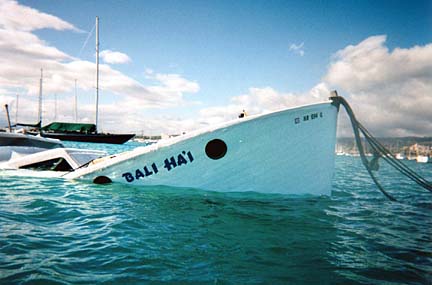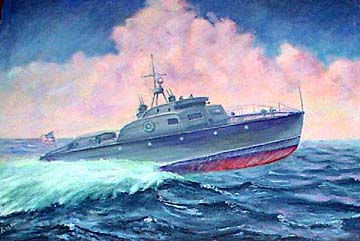


Rare craft may There is a forgotten World War II veteran craft lying at the bottom of nearby Keehi Lagoon.
be sunk for good
A Honolulu man may
see his historical crash
boat destroyedCrash boats rescued military in 1950s
By Burl Burlingame
Star-BulletinBut if the state has its way, it will be dumped in a landfill as soon as possible.
The craft in question is the "Bali Hai," a 63-foot former "crash boat" owned by David Ford of Honolulu.
The state impounded the craft Friday and has scheduled a hearing on its disposition this Friday.
Ford owes the state about $500 in fees and fines.
Such actions are "textbook" at Keehi, said Steven Thompson of the Boating Division of the Department of Land and Natural Resources.
"It's routine and happens all the time."
What is not textbook is that the boat sank at its moorings under mysterious circumstances Feb. 28 and that the fines include $11 a day for "having a submerged boat without a permit," said Ford.
He is also in arrears over his mooring fee, even though the line attaching his boat to the mooring buoy goes straight down into the water.
State officials attached the impoundment papers to the buoy.
What is not routine is that the boat might be the last of its kind still in the original fittings, and that maritime historians and museums across the country are closely watching Honolulu.
Historians at the Nimitz Center Pacific War Museum in Texas, the Defenders of America PT Boat Museum, the USS Bowfin Museum and others have expressed dismay that the boat may be destroyed.
Marine consultant Dennis Murphy, involved in restoring the USS Missouri, has visited maritime museums throughout the United States and England and "has yet to see one single AVR (Aviation Rescue Boat) in any of them. They are indeed rare."
The state Historic Preservation Division requested a delay in destroying the boat.
"Harbors has now agreed to wait at least a month," said Tonia Moy of the Historic Preservation Division. "The historians we've talked to seem to think it's worth saving, and we're trying. But no (museum) here will take it."
"Folks are interested, but not enough to come out here and plop down some money," said Murphy. "But then, Ford hasn't had much time to drum up support."
"For the first time that I can remember, the state of Hawaii is working quickly and efficiently, and it's aimed at destroying this boat before it can be preserved," said Ford, a medically disabled crane operator.
The Bali Hai is best known for its brief role in "Hawaii Five-O" as villain Wo Fat's headquarters, and it was "blown up" during filming.
Ford acquired the craft in 1997.
Researching the boat, Ford discovered that it has been in Hawaii since 1947, when it was surplused out of the military.
It still has the original military fittings, such as gun mounts and engines, and there is evidence of bullet damage from combat. He sank tens of thousands of dollars into restoring the craft.
When Bali Hai sank at her mooring two months ago, Ford suspected sabotage and hired a diver to document evidence of deliberate scuttling.
He has been unsuccessful in convincing authorities to treat the sinking as a criminal matter.
"Oh, it's a questionable piece, and now he's making allegations that the boat is museum quality," said Thompson. "Ford has had months to deal with it."

"Crash boats," or Aviation Rescue Boats (ARBs or AVRs), were used by the Navy, Army and Air Force to speed to downed pilots and were gradually replaced by helicopters in the 1950s. They were similar to PT boats in design and used powerful diesel engines.The 63-foot Miami-class crash boats were designed by Dair Long of the Miami Shipbuilding company, a direct descendant of the fast rum-runners built during prohibition. Miami Shipbuilding constructed 560 of these craft to various customers, the last being delivered in 1956. Crash boats rescued
military in 1950sAviation Rescue Boats served a
similar job to modern helicoptersStar-Bulletin
The class displaced 22 tons, and the hull was a hard-chine planing design. The vessels themselves were made of triple marine-ply with madapolin cloth between the plywood. They could reach a speed of 42 knots, and their normal range was 400 nautical miles.
These boats were also used for patrol and anti-submarine duty, and many were involved in combat operations during the war.